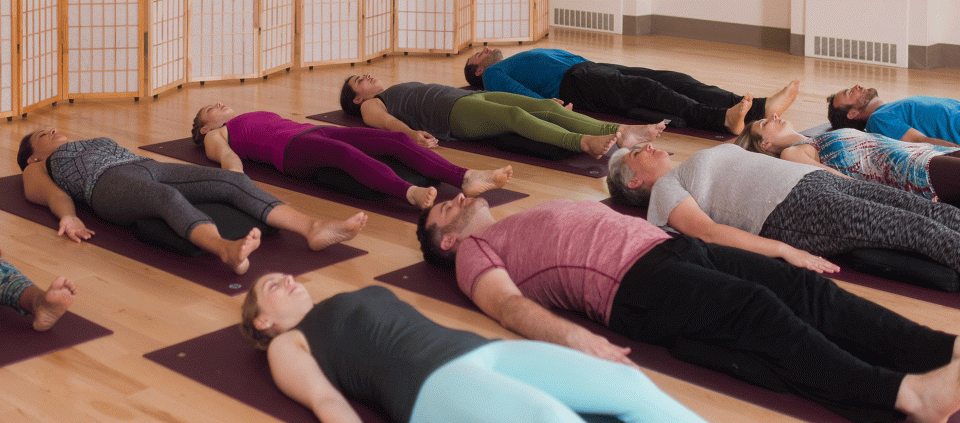The Art and Science of Yoga Nidra: A Q&A with Jennifer Reis

Jennifer Reis, E-RYT 500, is a Kripalu School of Yoga faculty member and the creator of Divine Sleep Yoga Nidra and Five Element Yoga. Her CD, Divine Sleep Yoga Nidra, has been the best-selling CD in the Kripalu Shop for years. We asked her to tell us about the benefits of yoga nidra, and why it’s great for wintertime.
What is yoga nidra?
Yoga nidra combines a body scan with breath awareness, and adds a visual and sense component. It’s often called yogic sleep, because it induces states of mind that are between being asleep and being awake, resulting in deep relaxation and rejuvenation. Most of the elements and principles of yoga nidra originally come from traditional teachings on yoga, breath awareness, and the koshas, and many teachers have created their own approach to the practice. Divine Sleep Yoga Nidra is informed by my training in Kripalu Yoga, Integrative Yoga Therapy, Ayurveda, shiatsu, and massage. From my Kripalu training, in particular, I bring a focus on witness consciousness, intuition, and creativity. There are eight stages to Divine Sleep Yoga Nidra, and as you move through the stages, you’re also moving through the five koshas, or layers, of your being. Each stage opens the doorway to the next stage, as you move deeper into relaxation.
What are the physiological effects of yoga nidra?
When you consciously relax, you’re switching off the sympathetic nervous system (fight/flight/freeze) and switching on the healing qualities of the parasympathetic nervous system. We spend most of our time in active (sympathetic) mode, and not enough in relaxation mode, which can lead to chronic conditions like insomnia, allergies, asthma, and digestive issues. For me, yoga nidra has been the easiest, least expensive, least time-consuming, and most enjoyable way to shift my nervous system into healing mode. It works better than anything else I’ve practiced.
What benefits does yoga nidra offer during the winter in particular?
Yoga nidra is a step-by-step way to induce pratyahara—withdrawal of the senses, going inward. As in nature, where everything goes beneath the ground and prepares to emerge in the spring, we, too, become fortified and revitalized when we go within. It’s an amazing practice to do in winter because it’s so deeply restorative and renewing. It’s just natural to rest more when it’s darker and cooler, and, because yoga nidra strengthens the immune system, it’s great for helping ward off the flus and bugs going around in the cold season. I find, for myself, yoga nidra helps me feel integrated, bringing together and nurturing all the parts of myself. It works best when practiced daily, and it doesn’t have to be for long; 20 minutes of yoga nidra are said to equate to three hours of sleep.
How can yoga teachers and healing professionals use yoga nidra to enhance their classes?
Everybody loves to relax, and everybody needs to learn how to relax through all levels of their being, because it often does not come naturally. Students will come to teachers forever if they guide yoga nidra! It’s a wonderful practice to lead during Savasana—you can incorporate all eight stages in as few as eight to 15 minutes. It’s a great bonus to offer during longer workshops and retreats, and it’s a really potent practice to lead in a group, because everybody’s energy is entraining together.
I know massage therapists who do yoga nidra with their clients to help them relax deeply before the session; one therapist uses it with a client who has fibromyalgia and is not able to relax and receive a massage unless the yoga nidra comes first. There are many people for whom silent, seated meditation is not accessible—because of chronic pain, anxiety, depression, or PTSD—and yoga nidra is an accessible, user-friendly way for them to learn about and experience meditation.
One of the greatest benefits for a teacher who guides yoga nidra is that, when you’re leading it, you’re also naturally practicing it and receiving all it has to offer. When practiced long-term, yoga nidra not only strengthens and supports our bodies, it actually changes the psyche and helps us shed limiting beliefs so we can live more fully and joyfully.
Find out about upcoming yoga nidra programs with Jennifer Reis at Kripalu.
© Kripalu Center for Yoga & Health. All rights reserved. To request permission to reprint, please e-mail editor@kripalu.org.